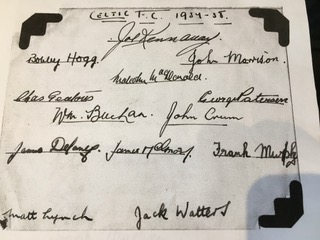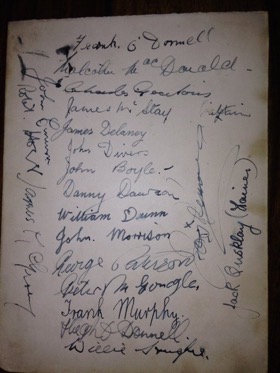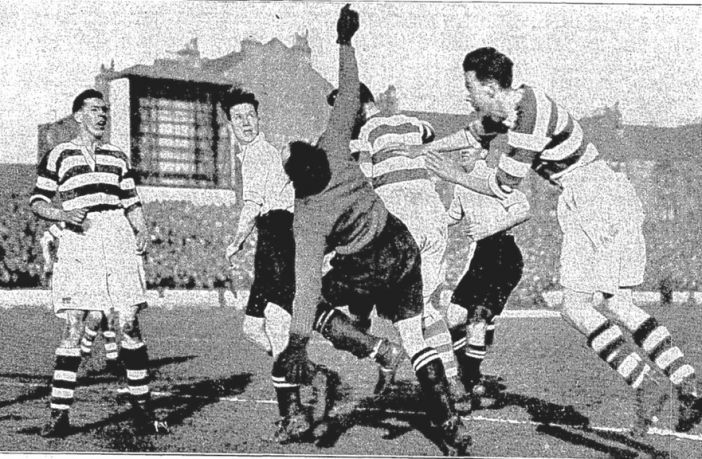And they gave us James McGrory…and Danny Dawson…
In the first part of this article, I mentioned how the publication of my Copenhagen Diary on the Celtic Star recently had prompted an old friend, Paddy, to get in touch. He wanted to show me a couple of photographs, containing Celtic autographs of the past, which had been in his possession for years. Paddy was looking for some information, background or context for these items.

Part one of this story covered the autographed sheet from 1937/38, compiled before the transfer of Willie Buchan and retiral of Jimmy McGrory pre-Christmas 1937, with the only question remaining as to how it had come about that the Celtic team, or representatives of the club, were in Kingussie in the Scottish Highlands, around that time. I’ll add my own thoughts on that particular query later.
The next three parts of the series looked at the second item presented by Paddy, an undated sheet containing the signatures of twenty men, some very famous and others unknown to me, however, all clearly associated with Celtic. This photograph had also been handed to the lady whose family owned the Star Hotel in Kingussie, albeit we then established that this very special piece of Celtic memorabilia related to a team several years before the Scottish, and, dare I say it, Empire champions of 1937/38. From 1933/34 actually. The mystery deepens.

Having reviewed the careers of seventeen of the twenty individuals on the second set of autographs, and with a few rambling diversions thrown in for good measure (Yes, I did pick up on your ‘you don’t say’ comment on Friday, Ed!), we will look at the last three names on the sheet in the final chapters.

Danny Dawson was born in that well-known Celtic hotbed of Larkhall in 1912 and signed for the Hoops from the local junior side on 4 June 1932, just before his 20th birthday. He would make his debut for the club in a 3-1 victory over Queen’s Park at Celtic Park on Saturday, 30 September 1933, ten years to the day when a certain James Johnstone would enter this world and thrill us for a generation.
Danny was a right-half and would take his bow in an unfamiliar line-up. Joe Kennaway was recovering from a broken finger, his place taken by John ‘Jock’ Wallace, the Falkirk-born keeper in the second of his only two seasons at Parkhead. At left-half was Willie Hughes, whose long and versatile Celtic career we covered extensively in the previous part of this story, whilst another Willie, Dunn in this case, was at centre-forward. Willie Dunn is the next player we will discuss so I’ll hang fire on him for the moment.
As well as Kennaway, Celtic were without the injured duo of Jimmy McGrory and Charlie Napier, whilst regular wing-half Peter Wilson was playing for the Scottish League against the Irish in Belfast, hence the opportunity for young Dawson. Future Hoops skipper William King Lyon was at centre-half for the Spiders. Danny was later praised in the media for ‘parting with the ball to advantage’, as goals from Hugh O’Donnell, Jimmy McStay and Alec Thomson saw Celts prevail at the expense of the amateurs.
Dawson would then step back into the reserve team, who played in the Scottish Alliance at that time, Peter Wilson back in his normal berth until a bad injury sustained after half-an hour in the 2-2 draw with Rangers at Celtic Park, on New Year’s Day 1934, opened up the door again for his young deputy. Danny would feature in four of the next five matches, starting with a 4-1 home win over Kilmarnock on Saturday, 6 January 1934, the youngster again impressing as a Jimmy McGrory double and further goals from Malcolm MacDonald and Charlie Napier secured the two points for Celtic.
The following Saturday, 13 January, would see a difficult trip to Tynecastle end in a 2-1 defeat, despite a Peter McGonagle penalty. McGrory was hurt again, a virtual passenger on the right-wing for an hour, having pulled a muscle, as were McGonagle, Napier and Celtic’s best player on the day, Joe Kennaway. The big Canadian included a penalty save within his goalkeeping masterclass, on a day when three spot kicks were awarded, Bobby Hogg also seeing his twelve-yards effort at the other end punched clear by Hearts stopper, Jack Harkness, the 1928 Wembley Wizard and future Sunday Post reporter.
Celtic would swap a packed Tynecastle for the 2,376 souls who turned out in the small Dumfriesshire town of Dalbeattie seven days later, as the local team took on the powerful Scottish Cup-holders in the first round. Dalbeattie Star were on their way to a fourth successive South of Scotland League title, however, they would be no match for Maley’s Bhoys, who romped to a 6-0 victory, Johnny Crum, in the side for the crocked McGrory, scoring four of those whilst Frank O’Donnell grabbed a double.

Peter Wilson would make a brief reappearance in the team the next week, for the goalless draw with St Johnstone at Parkhead, with Dawson dropping out. However, Wilson was not deemed fit enough for the visit to Ayrshire on the first Saturday in February, for the second round Scottish Cup-tie with Ayr United, Danny regaining his place at right-half. There was a record crowd of almost 24,000 packed inside Somerset Park for this one and they almost witnessed a shock, the Honest Men leading 2-1 with twenty minutes left. But this was the Scottish Cup and this was Celtic, the most renowned fighters of all. With defeat looming, the O’Donnell brothers took matters into their own hands, Frank equalising before young Hugh grabbed the winner, with just five minutes remaining. Earlier on, the reliable Peter McGonagle had scored with another penalty kick, to make it 1-1, following an early Robertson strike.
Frank O’Donnell would be on target again in the next round, a fortnight later, as Celtic eased by Falkirk 3-1 in front of 44,000 at Parkhead, his double supplemented by a goal from the returning McGrory, with Chic Geatons replacing Dawson at right wing-half. Danny would make one final appearance that season, the next Saturday, 24 February 1934, Geatons moving across to replace Willie Hughes at left-half as Celts surrendered an early two-goal lead to Aberdeen, goals from Johnny Crum and Willie Dunn, the game finishing 2-2. Wilson and Geatons would occupy the wing-back positions the following week as the holders crashed out of the Scottish Cup, more than 33,000 inside Love Street to watch St Mirren beat Celtic 2-0, just as they had in the 1926 final at Hampden, eight years earlier. The Paisley match in March 1934 was the infamous day travelling Celtic fans were ambushed at Bridgeton railway station.



